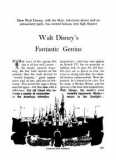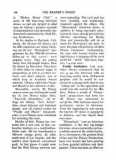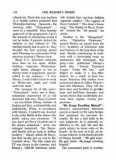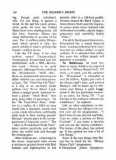[Condensed version of article "A Wonderful World: Growing Impact of the Disney Art," in Newsweek, 1955-04-18, pp.60-64]
The saga of the ageing him star is all too well known – the heady upward trajectory, the few brief seasons on the summit, then the swift descent to "second features," guest appearances and, of late, odd jobs on television. This month the saga is being enacted again — but this time with a difference. The old friend who becomes a master of ceremonies on the America television programme and may soon appear on British TV, has no paunchy or balding look to pain his old fans. His eyes are as glossy as ever, his voice as strong and clear, his cheerful bounce undiminished. Most important, he’s bound to be a hit. For his name is Mickey Mouse, and his sponsor is the man who created him, Walt Disney, the world's most versatile impresario. Mickey's return to the limelight – in "Mickey Mouse Club," a series of 180 hour-long television shows — is just one project in what may be history's greatest example of industrialized (and shrewdly synchronized) entertainment, Walt Disney Productions.
At his studios in Burbank, California, the 53-year-old Disney and his 900 employees are today blocking out 26 new "Disneyland" programmes for the 1955-56 television follow-up to this season’s most popular series. They are getting ready four full-length feature films for release by December. They have 15 other films in various stages of preparation, as well as assorted cartoons and short subjects, any of which may be Academy Award material. (Disney added two Oscars last March to his collection of 22.)
Meanwhile, nearly 80 Disney camera crews are combing the world for (1) new Disney nature films, "True-Life Adventures," (2) settings for Disney "Live Action" films about fictional and historical people, and (3) subject matter for "People and Places" documentaries, a new Disney series scheduled for unveiling this year.
Besides all this, Disney has ventured into a new and, to him, unfamiliar territory on a multimillion-dollar scale. He has transformed a 160-acre orange grove, 22 miles south-west of Los Angeles, into the world’s most fantastic amusement park. At first glance it might seem that the Walt Disney universe was over-expanding. But each part has been carefully, and beneficially, balanced against the others. The "Disneyland" television shows, in addition to being top-notch entertainment, have already proved to be effective advertising for Disney films and presumably will do as much for Disneyland, the park. In turn, the park will publicize all other Disney enterprises. Indisputably, the man who turned fantasy into high finance is bringing off the most profitable "treble" that show business has ever seen.
Family Institution: Last year, when Disney announced that he was going into television with an hour-long weekly show, Hollywood prophets said he would be outclassed in a strange field, that he was "selling out" to the opposition and would ruin the market for his own films. Before a month of "Disneyland" programmes had been run off, Disney was summoned to accept the 1954 Sylvania award for meritorious service to television. From the beginning he was among the top ten TV shows in popularity in America, and has stayed there ever since.
"Disneyland," now an American institution, is the first big-budget television show consistently and successfully aimed at the whole family. As a consequence, the greatest flood of fan mail the Disney Productions have ever known has been pouring in from grateful children and their parents. There has been an effect on schools too. Early this year teachers in a Seattle suburb protested that Thursday-morning classwork — the morning after "Disneyland" — came to a standstill. They heartily approved of the programme, but in the interests of scholarship would it not be better if parents tucked the children in bed without it? The teachers finally had to give in: they devoted the first morning period each Thursday to a discussion of the previous evening’s Disney show.
Rival U.S. television networks have been no less upset. Arthur Godfrey, long-time Wednesday-night leader, plunged as low as twenty-ninth in popularity, and admitted to his audience: "I love Disney. I wish I didn’t have to work on Wednesday night and could watch his show."
The runaway hit of this year’s "Disneyland" series was a three-instalment resurrection of an old American folk hero, Davy Crockett — an irresistible Disney mixture of fantasy and fact, sentimentality and authenticity. When, in accordance with history, Crockett was doomed to die at the Battle of the Alamo, the public outcry was enormous. "If you don’t get Davy Crockett out of the Alamo unharmed," wrote one outraged household, "the Bonniwell family will go back to Arthur Godfrey." Disney killed off Davy, but that hardly put an end to the Crockett show. The film made for TV was shown in the cinemas, and Disney’s 1955-56 television series will include four one-hour folklore segments entitled "The Legend of Davy Crockett." The show’s theme song, "The Ballad of Davy Crockett" headed the "hit parade" for weeks.
Another in the "Disneyland" series, "Operation Underseas," earned Disney an award from the U.S. Academy of Television Arts and Sciences as the best show of the year. Besides entertaining its audience with a fascinating essay on underwater film techniques, this programme publicized Disney’s latest film, "Twenty Thousand Leagues Under the Sea," and helped to make it a box-office winner. As a result, at least two major American film studios have announced plans to follow Disney’s lead into television. They will use their stars and facilities to produce hour and half-hour dramatic and variety shows that incidentally promote their regular cinema programmes.
"He Keeps Excelling Himself”: Disney’s extraordinary television success is based on the same factors that produced his previous triumphs. He has a firm faith in his own judgment; he is patiently indifferent to the safe bet and the quick return; he never rests on his laurels. At the core of it all, an associate believes, is the steady growth of Disney himself: "He gets wiser. He gets better. He keeps excelling himself."
The amusement park is another big, though quite calculated, risk. For one thing, it ignores a trend. In the last few years amusement parks all over the United States have been shutting down. All this time, however, Disney has clung stubbornly to an idea of his own. The 11-million-dollar Disneyland, which opened in July, has given solidity to what is perhaps the master's wildest dream.
Like the TV show, it has four sections named Tomorrowland, Fantasyland, Frontierland and Adventureland, with a fifth — Recreation Land – thrown in for good measure. Although Disney ruled out the old-fashioned "thrill ride," there are innumerable attractions to dilate childish eyes and drop parental jaws. The "Peter Pan Fly-Thru" is a trip in an air-borne pirate galleon over Never Never Land, where a midget pirate stationed behind a plastic "Skull Rock" fires ping pong balls at passengers. On the "Mr. Toad Drive-Thru," children in a replica of a 1903 car may barrel into a haystack, knock over a cow, crash into a barn, and finally glide back to their waiting parents through "pearly gates to the accompaniment of heavenly music." The "Alice in Wonderland Walk-Thru" takes visitors painlessly and safely down the rabbit hole and through the looking-glass.
Other features are : rocket trips to the moon; stagecoach rides across a miniature painted desert with Red Indians and highwaymen in hot pursuit; rides in a 105-foot paddle-steamer named the Mark Twain, in horse-drawn trams and fire engines, in canoes down rivers infested with rubberized crocodiles, plastic hippo-potamuses and ostensibly hostile "tribes."
For all its flamboyant dimensions, Disneyland has a sound financial basis. Leading industrial firms have invested six million dollars in park exhibits. It is estimated that within five years five million people will patronize it annually.
No Middleman: At least five times as many children are expected to see the "Mickey Mouse Club" TV show each week, and the audience for "Disneyland" is estimated at over 50 million. Eighty per cent of the Disney staff's time, and most of Disney’s, will be taken up by television and Disney is quite happy about it. He has particular reasons, as an artist, for liking TV. "I go directly to the audience without any middleman," he explains.
Like no other entertainer in television, Disney has 100 per cent control over all his programmes. "I don’t have to run and ask anybody, 'Can we make a picture on Davy Crockett?' I can make a decision and not ask the cinema exhibitors. The tempo of the place has picked up. It has pushed me into a lot of new things."
Some of the new things that Disney has in mind for his "Mickey Mouse Club" programme:
- Disneyland Junior Symphony Orchestra. "We'll have music with a lot of fun like Debussy and Ravel."
- Storytelling ballets like "Puss in Boots," "Cinderella," "Tom Sawyer."
- "The Mickey Mouse Newsreel," with a staff of correspondents roving all over the world.
- "The Flying Carpet" — trips all over the world with a flight simulator and screen.
- "When I Grow Up" — enquiries into such vocations as detective, airline pilot, engine driver.
On "Mickey Mouse Club" says Disney, "we'll do certain educational things, but that's a bad word to use. Let's say they will be entertainment dealing with factual subjects."
For a man whose output has been consistently winning favourable audience reaction since 1928, Disney is doing an odd kind of worrying about Mickey's TV series. "It is aimed directly at children," he says, "and I've never done anything just for children before."




